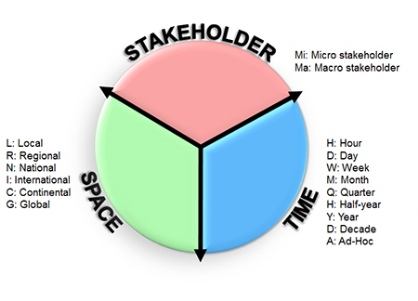ScopeDim
ScopeDim describes the relevant dimensions for the definition of the field of operation Any planning requires clearly defined application areas and spheres, i.e. the definition of scope. Thereby the spatial, timely and organizational dimensions of the activities and results have to be delimited. Areas beyond are excluded by definition. Complexity and the resulting effort depend on scope. It’s up to everybody to define the dimensions based on own needs. But it is useful to stick to the same classifications to learn from the experiences and to improve the estimation on a regular base.
ScopeDim is based on three dimensions with defined scales for space, time and stakeholder that will be described in the following.

Space
Space describes the geographical scope between local and global - the bigger the scope, the more complex the efforts for alignment, which result from distance, distributed time zones, and cultural differences. The effort increases exponentially and can culminate in dividing a project into several, independent projects, in order to have a realistic chance of success.
Time
Time describes the timely scope from hour to Ad-Hoc. The longer a project lasts, the more regular communication is needed. Projects that run longer than six months require additional communication effort, in order to maintain commitment of project members and momentum of the project. Additionally the time horizon can be defined as a cycle, e.g. regular, monthly reporting. It should be defined an appropriate cycle, i.e. not too frequent, in order to keep efforts of the participants small, but not to scarcely, in order to keep the interest of the participants.
Stakeholder
Stakeholders are interest groups that take part of an activity, have influences on it, or are impacted by the results. There are two groups of stakeholder: Micro-stakeholder (internal: e.g. superiors and colleagues, but also family and friends ) and Macro-stakeholder (external: e.g. Customers and suppliers, but also society, competition or media). The number of stakeholders and the complexity of balance of power determine the effort. With complex balance of power the installation of escalation procedures in form of decision-committees is recommended.
